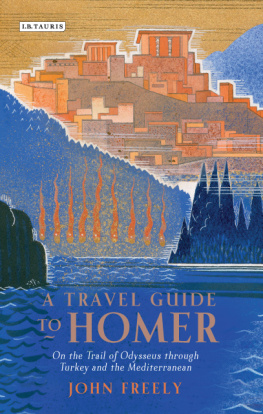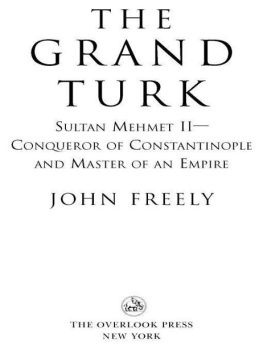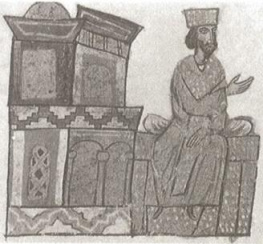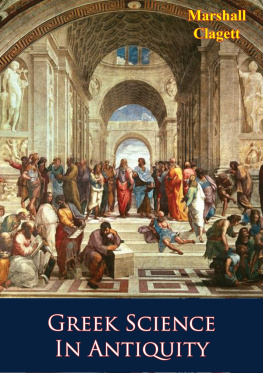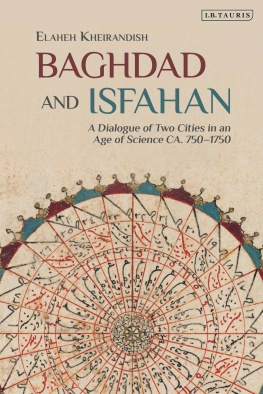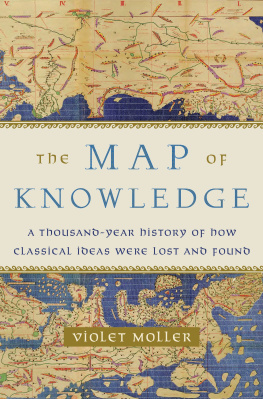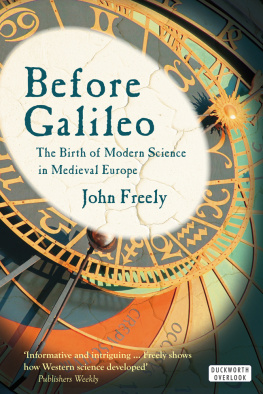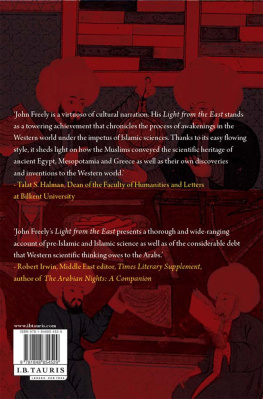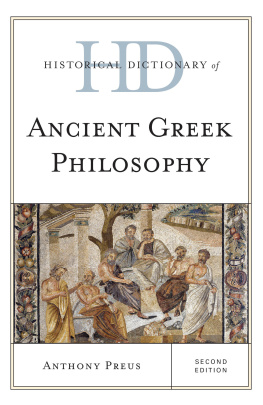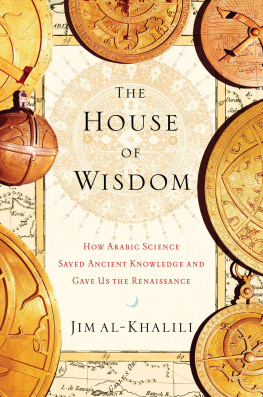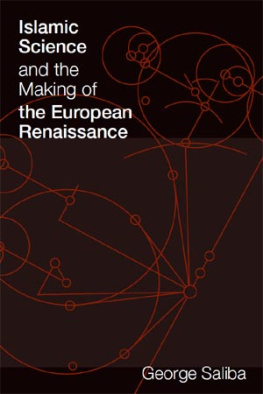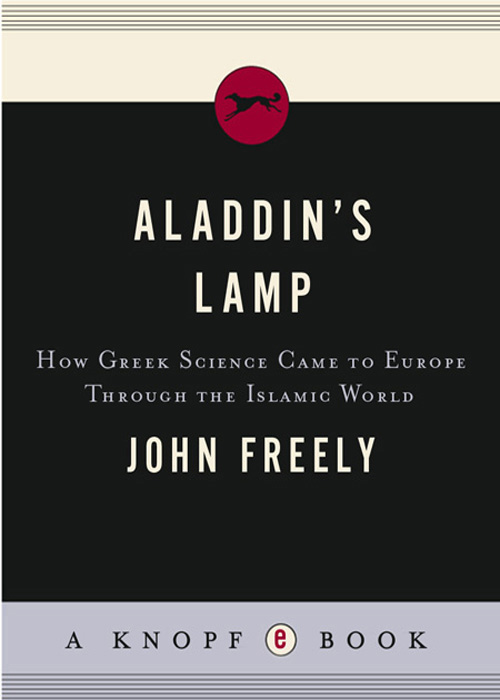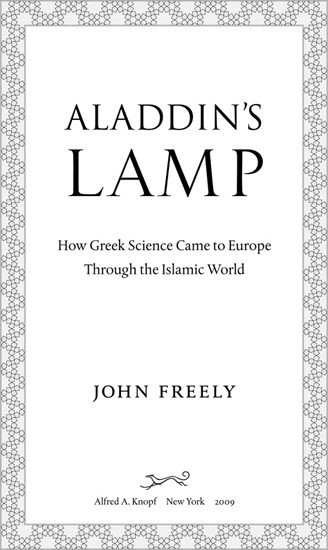14. The Debate over the Two World Systems
18.
LIST OF ILLUSTRATIONS
7 The Greek World in the Fifth and Fourth Centuries B.C.
9 The use of a gnomon in determining the seasons (from Thomas S. Kuhn, The Copernican Revolution)
29 The apparent motion of typical stars in the northern sky over a two-hour period, where the center of rotation is the north celestial pole, the projection of the north geographic pole (from Thomas S. Kuhn, The Copernican Revolution)
29 The apparent motion of the sun among the constellations; the effect is due to the fact that the observer, on the earth, is orbiting around the sun (from James B. Kaler, Astronomy!)
30 The tilt of the earth's axis as the cause of the seasons (from Robert H. Baker, Astronomy: An Introduction)
31 Above: The apparent motion of the sun through the constellations Aries and Taurus. Below: The apparent motion of Mars through the constellations Aries and Taurus, showing its retrograde motion (from Thomas S. Kuhn, The Copernican Revolution)
34 Aristotle's cosmology (from Petrus Apianus, Cosmographia per Gemma Phrysius Restituta [Antwerp, 1539]).
41 Measurement of the earth's circumference by Eratosthenes (from Cecelia Payne-Gaposchkin, Introduction to Astronomy)
45 Stellar parallax (from Cecelia Payne-Gaposchkin, Introduction to Astronomy)
46 From Aristarchus's On the Sizes and Distances of the Sun and the Moon. Above: The lunar dichotomy. Below: A lunar eclipse diagram (from Albert Van Helden, Measuring the Universe)
47 The conic sections (from Cecelia Payne-Gaposchkin, Introduction to Astronomy)
48 The epicycle theory of Apollonius (from G. E. R. Lloyd, Greek Science After Aristotle)
49 Inventions of Hero's. Above: Temple doors opened by fire on an altar. Below: A steam engine (from G. E. R. Lloyd, Greek Science After Aristotle)
51 The precession of the equinoxes. Above: Precession caused by the forces of the sun and the moon on the earth's equatorial bulge. Below: The path of the north celestial pole in the celestial sphere (from Robert H. Baker, Astronomy: An Introduction)
54 Ptolemy's concept of the equant (from A. Pannekoek, A History of Astronomy)
55 A simplified version of Ptolemy's planetary model (from G. E. R. Lloyd, Greek Science After Aristotle)
56 Ptolemy's experimental investigation of refraction (from G. E. R. Lloyd, Greek Science After Aristotle)
73 The Islamic World ca. A.D. 800.
88 The constellation Perseus shown in al-Sufi's Treatise on the Constellations of the Fixed Stars, from a tenth-century Arabic manuscript (from the British Library, Or. Ms. 5323 f.21v).
93 A water-raising machine, from a fourteenth-century Arabic manuscript of al-Jazari's Book of Knowledge of Ingenious Mechanical Devices (Bodleian Library, Oxford; Peter Whitfield, Landmarks in Western Science)
133 Development of the Hindu-Arabic numbers (from Carl Boyer, History of Mathematics)
163 The formation of primary and secondary rainbows (from Isaac Newton's Opticks)
186 The Copernican heliocentric theory, De Revolutionibus, 1543 (from Angus Armitage, Copernicus and Modern Astronomy)
194 A model of the Copernican system from Thomas Digges's A Prognostication Everlasting, 1576 (from Peter Whitfield, Landmarks in Western Science)
198 The Tychonic system (from Tycho Brahe, De Mundi aetherei recen-tioribus phaenomenis, Uraniborg, 1588; Kitty Ferguson, Tycho andKepler)
203 Kepler's first two laws of planetary motion (from Kitty Ferguson, Tycho and Kepler)
220 An illustration from Newton's Principia showing a projectile in orbit around the earth.
232 Takiyuddin's Istanbul Observatory (from the Shahanshahi-namah, sixteenth century, MS No. 1404, Istanbul University Library).
INTRODUCTION
Modern science traces its origins back to ancient Greece, beginning with the first philosophers of nature in the sixth century B.C. Greek science flourished for more than a millennium, ending with the collapse of classical civilization in the early Christian era, when virtually all the cities of the Greco-Roman world were utterly destroyed, beginning the Dark Ages of western Europe. And yet a thousand years later Greek classics inspired the Renaissance and brought about the rebirth of science. When Copernicus published his sun-centered planetary theory in 1543, he was reviving the work of a Greek astronomer who had proposed the same idea some eighteen centuries earlier.
How did ancient Greek science survive and by what means was it transmitted to western Europe? The answer to those questions is the main theme of this book, a story that begins on the Aegean shore of Asia Minor at Miletus, where the first Greek physicists emerged, influenced by ancient Mesopotamian lore in astronomy and mathematics. The story then moves in turn to classical Athens, Hellenistic Alexandria, imperial Rome, Byzantine Constantinople, Nestorian Jundishapur, Abbasid Baghdad, Fatimid Cairo and Damascus, Muslim Cordoba, Toledo of the Reconquista, Norman Palermo, and Latin Oxford and Paris in the thirteenth century, setting the stage for the European scientific revolution of the sixteenth and seventeenth centuries, and finally to Mongol Samarkand and Ottoman Istanbul, tracking the last peak of Islamic science and its long decline.
The story has never been fully told in a book for the general reader, and there is not even a specialist work on the subject as a whole, as I learned when I began my career as a physicist and started reading about the history of science. My first studies in this field began in 1966-67, when I had a postdoctoral fellowship at Oxford under the tutelage of Alistair Crombie, who pioneered the study of how Greek science came to western Europe in translation from Arabic into Latin after having been preserved and developed in the Islamic world. This led me to study the Islamic renaissance of the eighth and ninth centuries, when the translation of Greek scientific and philosophical works into Arabic under the Abbasid caliphs in Baghdad began the first stage in the journey that would eventually lead to the emergence of science in Europe. According to Dimitri Gutas of Yale, one of the leading authorities on the transmission of Greek culture to the Islamic world, the Graeco-Arabic translation movement of Baghdad constitutes a truly epoch-making stage equal in significance to that of Pericles Athens, the Italian Renaissance, or the scientific revolution of the sixteenth and seventeenth centuries, and it deserves so to be recognized and embedded in our historical consciousness.


